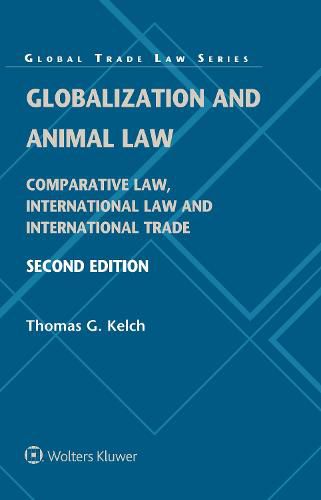Readings Newsletter
Become a Readings Member to make your shopping experience even easier.
Sign in or sign up for free!
You’re not far away from qualifying for FREE standard shipping within Australia
You’ve qualified for FREE standard shipping within Australia
The cart is loading…






The rise of the globalized economy has rendered an even more profound change in the relationship between humans and other animals than the ancient progression from huntergatherer to agricultural society. In today’s global markets, multinational corporations exploit the economic value of animals throughout the world on an unprecedented scale.
The philosophical and legal notions that animals are mere unfeeling machines or pieces of property, although more or less taken for granted for centuries, has been challenged, if not burst asunder, in recent decades (in law, moral philosophy, and cognitive and other sciences), and regulation of the treatment of animals in agriculture, experimentation, entertainment and other areas has begun to make substantial inroads in national and international law.
This book provides a detailed analysis of international and comparative animal law focusing on the impact of today’s globalized economy on animal law. Describing a wide range of domestic and international laws relating to the treatment of animals, the author explicates the sorts of legal rules which affect the global animal marketplace. Representative norms in existing animal protection laws are analyzed and critiqued, illustrating the diverse approaches taken by different countries and by the international community in regulating uses of animals.
Among the issues covered are the following:
To ensure the consideration of a full range of legal approaches, the laws analyzed come from a wide variety of countries and jurisdictions, including Australia, Austria, Brazil, Canada, the EU, Germany, India, Ireland, New Zealand, Switzerland, the UK, and state and federal laws of the US. Numerous international treaties and conventions relevant to animal treatment and animal law are also covered, including the Berne Convention for the Protection of Literary and Artistic Works, the CITES Convention, the European Convention for the Protection of Animals Kept for Farming Purposes, the European Patent Convention, the GATT Treaty, the TRIPS Agreement and the Universal Copyright Convention.
It is not difficult to grasp, given the continuing increases in production, consumption and use of animals and animal products worldwide, that legal initiatives in this often emotional and acrimonious area of law are frequently contentious and hard fought. But this is really just the dawn of animal law, which has only recently become recognized as an important cutting-edge topic, and this area of the law promises to develop rapidly in the future. This book is enormously valuable in contributing to the continuing development and understanding of this law, clearly laying out the contours and boundaries of existing animal laws in our global economy, and allowing legal educators, concerned lawyers and policymakers to teach, formulate proposals, argue cases and defenses, and secure a firm purchase on future trends and developments in animal law.
$9.00 standard shipping within Australia
FREE standard shipping within Australia for orders over $100.00
Express & International shipping calculated at checkout
The rise of the globalized economy has rendered an even more profound change in the relationship between humans and other animals than the ancient progression from huntergatherer to agricultural society. In today’s global markets, multinational corporations exploit the economic value of animals throughout the world on an unprecedented scale.
The philosophical and legal notions that animals are mere unfeeling machines or pieces of property, although more or less taken for granted for centuries, has been challenged, if not burst asunder, in recent decades (in law, moral philosophy, and cognitive and other sciences), and regulation of the treatment of animals in agriculture, experimentation, entertainment and other areas has begun to make substantial inroads in national and international law.
This book provides a detailed analysis of international and comparative animal law focusing on the impact of today’s globalized economy on animal law. Describing a wide range of domestic and international laws relating to the treatment of animals, the author explicates the sorts of legal rules which affect the global animal marketplace. Representative norms in existing animal protection laws are analyzed and critiqued, illustrating the diverse approaches taken by different countries and by the international community in regulating uses of animals.
Among the issues covered are the following:
To ensure the consideration of a full range of legal approaches, the laws analyzed come from a wide variety of countries and jurisdictions, including Australia, Austria, Brazil, Canada, the EU, Germany, India, Ireland, New Zealand, Switzerland, the UK, and state and federal laws of the US. Numerous international treaties and conventions relevant to animal treatment and animal law are also covered, including the Berne Convention for the Protection of Literary and Artistic Works, the CITES Convention, the European Convention for the Protection of Animals Kept for Farming Purposes, the European Patent Convention, the GATT Treaty, the TRIPS Agreement and the Universal Copyright Convention.
It is not difficult to grasp, given the continuing increases in production, consumption and use of animals and animal products worldwide, that legal initiatives in this often emotional and acrimonious area of law are frequently contentious and hard fought. But this is really just the dawn of animal law, which has only recently become recognized as an important cutting-edge topic, and this area of the law promises to develop rapidly in the future. This book is enormously valuable in contributing to the continuing development and understanding of this law, clearly laying out the contours and boundaries of existing animal laws in our global economy, and allowing legal educators, concerned lawyers and policymakers to teach, formulate proposals, argue cases and defenses, and secure a firm purchase on future trends and developments in animal law.